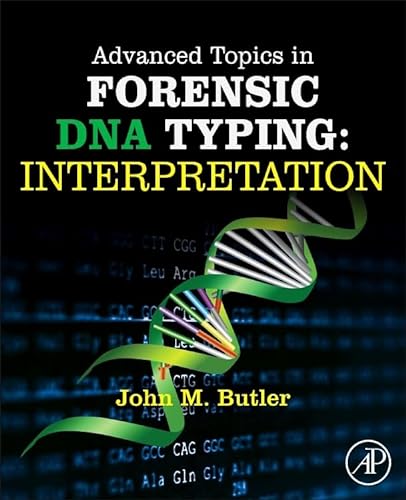
Synopsis
The first edition of Forensic DNA Typing, published in 2001, by John Butler quickly established itself as the gold-standard reference for the field. Over the next ten years, the vast amount of new information uncovered has resulted in this new volume, Advanced Topics in Forensic DNA Typing: Interpretation. This book builds upon the previous two editions of Forensic DNA Typing books, but with a focus on mixture interpretation and statistical analysis and is a companion to the bestselling Advanced Topics in Forensic DNA Typing: Methodology, published in September 2011.
- Provides forensic DNA analysts coverage of the crucial topic of DNA mixture interpretation and statistical analysis of DNA evidence
- Worked mixture examples illustrate the impact of different statistical approaches for reporting results
- Includes allele frequencies for 24 commonly used autosomal STR loci, the revised Quality Assurance Standards which went into effect September 2011
"synopsis" may belong to another edition of this title.
About the Author
John M. Butler is a NIST Fellow and Group Leader at the U.S. National Institute of Standards and Technology, Gaithersburg, Maryland. Dr. Butler earned his PhD from the University of Virginia while doing DNA research in the FBI Laboratory's Forensic Science Research Unit. He has over 100 publications in this field and is a frequent presenter on the topic of DNA typing.
From the Back Cover
Advanced Topics in Forensic DNA Typing: Interpretation builds upon the previous two editions of John Butler's internationally acclaimed Forensic DNA Typing textbooks with forensic DNA analysts as its primary audience. Intended as a third-edition companion to the Fundamentals of Forensic DNA Typing volume published in 2010 and Advanced Topics in Forensic DNA Typing: Methodology published in 2012, this book contains 16 chapters with 4 appendices providing up-to-date coverage of essential topics in this important field. Over 80% of the content of this book is new compared to previous editions.
"About this title" may belong to another edition of this title.
Search results for Advanced Topics in Forensic DNA Typing: Interpretation
Advanced Topics in Forensic DNA Typing: Interpretation
Seller: BookHolders, Towson, MD, U.S.A.
Condition: Good. [ No Hassle 30 Day Returns ][ Ships Daily ] [ Underlining/Highlighting: NONE ] [ Writing: NONE ] [ Edition: first ] Publisher: Academic Press Pub Date: 10/22/2014 Binding: Hardcover Pages: 608 first edition. Seller Inventory # 6940786
Advanced Topics in Forensic DNA Typing: Interpretation
Seller: PBShop.store UK, Fairford, GLOS, United Kingdom
HRD. Condition: New. New Book. Shipped from UK. Established seller since 2000. Seller Inventory # FD-9780124052130
Advanced Topics in Forensic DNA Typing : Interpretation
Seller: GreatBookPrices, Columbia, MD, U.S.A.
Condition: New. Seller Inventory # 21637191-n
Advanced Topics in Forensic DNA Typing: Interpretation (Hardcover)
Seller: Grand Eagle Retail, Bensenville, IL, U.S.A.
Hardcover. Condition: new. Hardcover. Advanced Topics in Forensic DNA Typing: Interpretation builds upon the previous two editions of John Butlers internationally acclaimed Forensic DNA Typing textbook with forensic DNA analysts as its primary audience. Intended as a third-edition companion to the Fundamentals of Forensic DNA Typing volume published in 2010 and Advanced Topics in Forensic DNA Typing: Methodology published in 2012, this book contains 16 chapters with 4 appendices providing up-to-date coverage of essential topics in this important field. Over 80 % of the content of this book is new compared to previous editions. Shipping may be from multiple locations in the US or from the UK, depending on stock availability. Seller Inventory # 9780124052130
Advanced Topics in Forensic DNA Typing : Interpretation
Seller: GreatBookPrices, Columbia, MD, U.S.A.
Condition: As New. Unread book in perfect condition. Seller Inventory # 21637191
Advanced Topics in Forensic DNA Typing: Interpretation
Seller: PBShop.store US, Wood Dale, IL, U.S.A.
HRD. Condition: New. New Book. Shipped from UK. Established seller since 2000. Seller Inventory # GB-9780124052130
Advanced Topics in Forensic DNA Typing: Interpretation
Seller: Ria Christie Collections, Uxbridge, United Kingdom
Condition: New. In. Seller Inventory # ria9780124052130_new
Advanced Topics in Forensic DNA Typing : Interpretation
Seller: GreatBookPricesUK, Woodford Green, United Kingdom
Condition: New. Seller Inventory # 21637191-n
Advanced Topics in Forensic DNA Typing: Interpretation
Seller: Revaluation Books, Exeter, United Kingdom
Hardcover. Condition: Brand New. 1st edition. 608 pages. 9.75x8.25x1.25 inches. In Stock. Seller Inventory # __0124052134
Advanced Topics in Forensic DNA Typing : Interpretation
Seller: GreatBookPricesUK, Woodford Green, United Kingdom
Condition: As New. Unread book in perfect condition. Seller Inventory # 21637191
